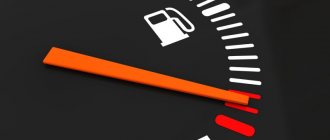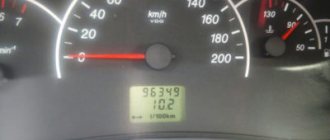By kanistra Posted on 04/23/2015
The VAZ 2106 can easily be called a legend of several eras. The rear-wheel drive model replaced the no less famous 2103, and took its place on the assembly line in 1976. And only in 2006 the “six” were retired. It must be said that the car became a “long-liver” due to its complex of qualities. First of all, we are talking about the efficiency of the engine and the simplicity of repairs. Production of 2106 was carried out in Togliatti for a long time, but by the end of the twentieth century the model began to be assembled in Syzran, and then in Izhevsk.
Fuel consumption VAZ 2106 1.3l.
The VAZ 2106 was equipped with a five-speed gearbox and a gasoline carburetor engine with a displacement of 1300 cc. and power 64 hp. The car has a top speed of 145 km/h and accelerates from zero to hundreds in 18 minutes. Fuel consumption within the city is 9.5 liters, and on the highway – 7.6-8 liters per hundred kilometers.
Real fuel consumption of VAZ 2106 1.3l.
- Andrey. Kirov. I inherited a VAZ 2106 produced in 1992 from my father. This was five years ago. Of course, at that time there were practically no “original” spare parts in the car, but the engine worked “like a clock” and never let me down. If you don’t press the gas pedal to the floor on the highway and warm up the car thoroughly in winter, then there will be no problems with it. I think that a domestically assembled engine, with proper and timely maintenance, will last for many more decades. As for fuel consumption, my 1.3 liter engine “eats” about ten liters in the city, and on the highway – within seven liters per hundred.
- Oleg. Tomsk I bought a VAZ 2106 from a neighbor in 2005 with a 1.3-liter engine. The car came off the assembly line back in 1988, so you understand that its condition was not the best. I overhauled the engine, replaced all consumables, slightly modernized the interior and drove it without problems for five years. I was also completely satisfied with fuel consumption: in the city no more than ten liters, and on the highway during normal driving it was possible to keep within 7.5-8 liters.
- Sergey. Adler. I bought a VAZ 2106 from 1985 specifically for taxi work. The previous owner loved his car, so I got it in very good condition. I drove the “Six” for almost seven years and during this time it did not create any special problems for me. If we talk about fuel consumption, then I got about ten liters in the city and eight on the highway.
- Vladimir. Kazan. The VAZ 2106 with a 1.3-liter engine is a good domestic car that, with proper care, can faithfully serve for several decades. I bought my ’85 “six” in 2001 in order to take my family to the dacha and visit relatives. In addition, I also drove the car for work, so it rarely came into my garage. During the entire period of operation, I never looked into the engine, since there was no need for this, it worked properly and did not let me down. In terms of fuel consumption: in the city with normal traffic it was up to ten liters, and on the highway - 8-8.5 liters per hundred.
- Alexei. Ulyanovsk VAZ 2106 1.3 liter - this is my first car. I bought it new off the production line in 2001 and drove it for almost ten years. Of course, immediately after the purchase I had to tighten up a few things and blow out the bottom, but otherwise I had no complaints about the car. The machine is a real “workhorse”; I have no doubts about this during the entire time I used it. In terms of consumption, I can say the following: in the city I got from eight to ten liters, and on the highway (if I didn’t press the accelerator pedal to the floor) - 8-8.5 liters per hundred kilometers.
How to reduce fuel consumption! General tips/carburetor modifications/measurements
Video on the topic of fuel consumption in your car. Not the best way to increase engine efficiency.
Another reason for increased gas consumption is another problem: incorrect adjustment of the wheel bearings. Also, all this tire pressure is not influenced by the angles of the front wheels. These factors reduce engine power, because it is spent not on accelerating the car, but on overcoming the rolling resistance of the wheels.
Similar news
Partially helping to assess the degree of influence of these factors can be the length of the track that the car coasts from a certain speed to a stop. VAZ fuel consumption When installing bearings on a car, you should not clamp them too hard, this will cause them to wear out quickly. Tire pressure also affects fuel consumption.
Fuel consumption of the VAZ 2107: how to reduce consumption But this, as a rule, is almost never taken into account. Especially when planning a long journey, you should check the tire pressure. By the way, if you plan to drive on a good road surface, you can increase it by about 0.2. Fuel consumption of cars of the first VAZ 2101 family is at minimum consumption. As a result, by eliminating malfunctions and correctly adjusting the car’s chassis, you can save about another 0.5 liters of gasoline per 100 km. ways.
The next step will be the gas distribution mechanism. It also plays an important role in the efficiency of the power unit. How to properly adjust the ignition on a VAZ 2109? What are the ways to do it yourself? So, if the valves do not open at the right time or to the required height, the engine loses power.
The cooling system, or rather its fan, can also indirectly affect fuel consumption. As you know, the “kopek” does not have an electric drive and, as a result, works all the time, both in summer and winter. Therefore, in winter you can try to dismantle the fan. Note that in this case it is necessary to additionally install two additional nuts on the mounting bolts to prevent them from touching the water pump housing.
So, as a result of the actions taken, it is possible to reduce the fuel consumption of your car by an average of 1-1.5 l/100 km. And this, you see, is not bad considering the minimal financial investment!
Similar news
Fuel consumption VAZ 2106 1.5l.
VAZ 2106 1.5. It was equipped with a gasoline carburetor engine and a five-speed manual transmission. The engine displacement is 1452 cc and power is 72 hp. Engine torque is 104 Nm at 3400 rpm. The car has a top speed of 150 km/h and accelerates from zero to hundreds in 17 seconds. Fuel consumption VAZ 2106 1.5l. in the city it is 9.8 liters, on the highway - 7.4 liters per hundred kilometers.
Other cars: Opel Insignia fuel consumption
Real fuel consumption of VAZ 2106 1.5l.
- Vladislav. Samara. Six years ago I bought a second-hand “six” with a one and a half liter engine for work and I drive it to this day. What can I say, in my opinion, this is the best car for our roads. In addition, considering that the car rolled off the assembly line back in 1988, its condition can be said to be ideal. If your head “cooks” and your hands grow from the right place, then you can use the “six” for more than a dozen years. In terms of gasoline consumption, my average is ten liters in the city and up to 8.5 on the highway.
- Dmitriy. Kazan. My “swallow”, after a major overhaul in 2001, still doesn’t drive, but flies! I completely overhauled the engine and gearbox, changed all the consumables and slightly modernized the interior. Since then there have been no major problems. In terms of gasoline consumption, I get about ten liters when driving around the city and no more than nine on the highway.
- Egor. Samara. I inherited my “six” with a one and a half liter engine from my father in 1995. My father loved the car very much and looked after it carefully. The machine served me faithfully for ten years, after which I sold it. It seems to me that for our expensive VAZ 2106 it is exactly what we need. The machine is stable, durable, convenient, and most importantly, not expensive to maintain. In terms of gasoline consumption, I got no more than 10 liters in the city (in normal traffic) and up to nine liters on the highway.
- Ivan. Saint Petersburg. I bought the car off the production line in 1993. Of course, for greater comfort and safety I had to tighten some parts and blow out the bottom, but otherwise I was completely satisfied with the car. Playful, easy to control and stable. In addition, the suspension is not very stiff, and the interior is spacious and comfortable. I sold my “six” five years ago and today I already regret it. The car “eats” relatively little, and maintenance costs pennies. My gasoline consumption averaged up to 10 liters within the city and 7.5-8 liters on the highway, which I think is quite normal.
- Victor. Kostroma. I bought a used 1993 Six from a work colleague. What can I say, the car is a real classic of the domestic automobile industry. A spirited engine, a relatively soft suspension, a comfortable interior that warms up quickly in winter. In addition, if the hands grow from the right place, then maintenance costs mere pennies. Fuel consumption is also within normal limits: in the city up to ten liters, and on the highway (if you don’t drive) you can keep within 7.5-8 liters per hundred kilometers.
- Nikita. Moscow. I bought a “six” second hand after a major overhaul. At that time, it already had 7,000 kilometers on it. Today the mileage is 25,000 km, and I still have no complaints about the machine. It picks up speed quickly, has good stability and controllability, and most importantly, is inexpensive to maintain. In terms of gasoline consumption, everything also suits me: in the city with heavy traffic it turns out to be up to ten liters, and on the highway with normal driving you can keep within 8 liters.
- Victor. Stavropol. It seems to me that the “six” with a one and a half liter engine is an ideal car for those who are just acquiring driving skills and are trying to figure out how everything works in the engine, gearbox, etc. The car is easy to control, stable and playful. I’ve been riding mine for five years now and I don’t have any particular complaints, although I bought it used. Gasoline consumption is also within normal limits: in the city I get no more than ten liters, and on the highway, if I don’t drive, it’s 7.5-8 liters.
- Natalia. Belgorod. My husband bought a VAZ 2106 from 1988 from a friend. He said that this is an ideal option for acquiring driving skills. And today I understand that he spoke the truth. We made a capital investment immediately after the purchase, and to this day we have no complaints about the machine. Of course, this is not a foreign car with climate control and leather seats, but the car is quite enough for everyday movement around the city. In terms of gasoline, I get about ten liters in the city and 8-8.5 on the highway.
Other cars: Audi Q5 fuel consumption
Why does the VAZ 2106 increase gasoline consumption?
The amount of fuel consumed by an internal combustion engine depends on many factors - technical and operational. All reasons can be divided into 2 groups:
- Primary factors that significantly affect fuel consumption.
- Minor nuances that individually slightly increase gasoline consumption.
Any problem belonging to the first group becomes noticeable immediately - the fuel tank of the VAZ 2106 is literally emptied before our eyes. Secondary factors do not appear so clearly - the simultaneous impact of several small problems is necessary for the car enthusiast to pay attention to the increased consumption.
Primary reasons increasing consumption by 10-50%:
- critical wear of the engine cylinder-piston group and cylinder head valves;
- malfunction of fuel supply elements - fuel pump or carburetor;
- problems with the ignition system;
- driving with jammed brake pads;
- aggressive driving style, which involves frequent dynamic acceleration and braking;
- use of low-quality gasoline with a low octane number;
- harsh operating conditions of the car - towing a trailer, transporting goods, driving on dirt and snowy roads.
When towing a large trailer, fuel costs increase by 30-50%
It is worth noting one malfunction that occurs on older cars - fuel leakage through a rotten gas tank or fuel line. Although the tank is hidden in the trunk and is well protected from external influences, in some cases corrosion reaches the bottom of the tank due to a completely rusted bottom.
Minor points that add 1-5% to consumption:
- insufficient tire pressure;
- winter driving with a cold engine;
- violation of the aerodynamics of the car - installation of large mirrors, various flags, additional antennas and non-standard body kits;
- replacing standard tires with a non-standard set of larger sizes;
- malfunctions of the chassis and suspension, leading to increased friction and the extraction of excess engine power;
- installation of powerful electricity consumers that load the generator (additional lights, speakers and subwoofers).
A large number of body kits and decorative external elements do not help save fuel, since they disrupt the aerodynamics of the “six”
Drivers often consciously increase their fuel consumption. An example is the operation of the “six” in difficult conditions or the installation of electrical equipment. But for the sake of savings, you can fight other reasons - various malfunctions and a “jerky” driving style.
More information about the electrical equipment of the VAZ-2106: https://bumper.guru/klassicheskie-modeli-vaz/elektrooborudovanie/elektroshema-vaz-2106.html
The “gluttony” of the car may increase due to tuning - increasing the engine displacement, adding turbocharging and other similar measures. When, by replacing the crankshaft, I increased the cylinder displacement of the 21011 engine to 1.7 liters, the consumption increased by 10-15%. To make the “six” more economical, it was necessary to install a more modern Solex carburetor (model DAAZ 2108) and a five-speed gearbox.
Installing a Solex carburetor from a VAZ 2108 allows you to more flexibly adjust the fuel supply on the “six” without losing acceleration dynamics
Fuel consumption VAZ 2106 1.6
VAZ 2106 1.6. with a manual five-speed gearbox, equipped with a gasoline carburetor engine with a working volume of 1569 cc and a power of 75 hp. Maximum torque Nm at rpm – 116/3000. The maximum speed of the car is 155 km/h. acceleration from zero to hundreds is carried out in 16 seconds. Fuel consumption: city - 10.3 liters, highway - 7.4 liters per hundred kilometers.
Real fuel consumption of VAZ 2106 1.6l.
- Sergey. VAZ 2106 produced in 1976 is my first car. What can I say, the car is not bad, but it came to me in terrible condition. I made a capital investment, after which I rode it for another seven years. During this time there were no special complaints. If breakdowns did occur, in most cases they were able to be fixed independently with minimal investment. In terms of consumption after repair, it turned out exactly as stated in the passport - no more than 7.5 liters on the highway and a little more than ten in the city.
- Eugene. Astrakhan. I bought a six with a 1.6-liter engine from a neighbor a couple of years ago. The previous owner's car sat in the garage for a long time, so I had to tinker with it. Despite the fact that the car came off the assembly line back in 1984, it is in good condition. Now I also want to repaint the body and install new seats for greater comfort, and I can still ride for at least a hundred years!))) In terms of gasoline consumption, I can say the following: in the city 10-11 liters, on the highway no more than 8.5 liters per hundred.
- Valery. Kostroma. I recently bought a six with a 1.6 engine from a friend. I can only say one thing: you shouldn’t buy such a car after driving a foreign car for several years. On my first trip I almost went crazy! At a speed of 70-80 km/h, everything in the cabin begins to creak and rattle, and when accelerating to 120, it throws the car from side to side. Of course, taking into account the age of the car (1979), you can make a discount, but still... In terms of fuel consumption, of course, everything is more than good: in the city - a little more than ten liters, and on the highway during normal driving you can keep within 8 liters.
- Nikolai. Kaluga. My father gave me a VAZ 2106. This was my first car, which I could not get enough of. I rode an “old lady” made in 1979 for almost seven years and I can say with confidence that this is an ideal vehicle for those who want not only to gain driving skills, but also to understand what and how it works in a car. For gasoline, I got no more than ten liters in the combined cycle.
- Marina. Kazan. My husband gave me a VAZ 2106 from 2000. What can I say: the car is excellent, easy to control and playful. In addition, even the most complex repairs are not expensive, which is also nice. My gasoline consumption is as accurate as it is stated in my passport: 7.4 liters on the highway and 10.3 in the city.
- Denis. Krasnodar. I took a VAZ 2106 produced in 1999 for work. I do repairs and constantly travel to customers, both around the city and beyond. The car suits me perfectly. It is easy to control, stable, with a relatively soft suspension. In addition, even when I load the roof rack with building materials, the speed also develops quite quickly and it pulls well downhill. In terms of gasoline consumption: in the city with normal traffic it turns out to be 10-11 liters, and on the highway, if you don’t drive, you can keep within 7.5-8 liters.
- Oleg. Khabarovsk. The main advantage of the VAZ 2106, as for me, is the ease of repair and maintenance. If the hands grow from the right place, then repairs generally cost pennies. I’ve been driving my “six” for ten years now and I have no complaints about this “workhorse”. Fuel consumption also suits me: in the city I spend a little more than ten liters, and on the highway I get within eight.
- Peter. Rostov-on-Don. My “six” served me faithfully for fifteen years. This car was created for our roads and there can be no doubt about it. Over the entire period of operation, I, of course, replaced the bulk of the “original” spare parts and once made a major overhaul of the engine. But even so, maintenance over the entire fifteen years cost me mere pennies. As for fuel consumption, my “swallow” “ate” about 10.-11 liters in the city and up to eight on the highway.
- Maksim. Chelyabinsk. My father bought a VAZ 2106 2000 from the factory. Of course, I immediately had to go to the service station to tighten the bolts where necessary and blow out the bottom. Otherwise, my father was completely satisfied with the car and drove it for ten years, after which he gave it to me. I want to say this: if you take care of the car, carry out repairs and maintenance on time and drive carefully, then the VAZ 2106 will last at least a hundred years. In terms of gasoline, even today I get it practically, as it is written in my passport: 10.5 -11 liters in the city and 7.5-8.5 on the highway.
- Konstantin. Vladimir. I bought a VAZ 2106 with a 1.6-liter engine to work in a taxi service. I am completely satisfied with the car. The engine works properly, even in severe frosts the car starts with half a turn, repairs and maintenance are not expensive, and gasoline consumption does not exceed the figures specified in the documents: 10.5 liters in the city and 7.5 liters when driving on the highway.
Other cars: Mazda Tribute fuel consumption owner reviews
Diagnosis and resolution of technical problems
A serious increase in fuel consumption never occurs without reason. The “culprit” is often detected by the following signs:
- drop in engine power, noticeable deterioration in traction and acceleration dynamics;
- the appearance of the smell of gasoline in the car interior;
- idle failure;
- jerks and dips during movement;
- the engine suddenly stalls while driving;
- at idle, the crankshaft speed “floats”;
- The smell of burnt pads and noise from increased friction can be heard from the wheels.
The listed symptoms may indicate one or more technical problems. To save fuel, learn to quickly recognize the source of a malfunction and promptly fix the problem - yourself or at a service station.
Cylinder piston and valve group
Natural wear of pistons and rings causes the following consequences:
- A gap is formed between the walls of the cylinders and pistons, into which gases from the combustion chamber penetrate. Passing through the crankcase, exhaust gases are sent through the ventilation system for afterburning, contaminating the carburetor air jets and excessively enriching the fuel mixture.
Gases penetrate through the gap around the worn piston, and the compression of the combustible mixture deteriorates.
- Compression drops and gasoline combustion conditions worsen. To develop the required power, the engine begins to consume more fuel, and the lion's share of unburned fuel is thrown out through the exhaust tract.
- Motor oil penetrates into the combustion chambers, aggravating the situation. A layer of carbon deposits on the walls and electrodes causes overheating of the cylinder head.
Critical wear of the cylinder-piston group increases fuel consumption by 20-40%. Valve burnout leads to complete failure of the cylinder and an increase in flow rate by 25%. When 2 cylinders are switched off in a VAZ 2106 engine, gasoline losses reach 50%, and the car practically “does not move.”
While repairing Zhiguli cars, I repeatedly came across cars that arrived on two cylinders - the rest were “dead”. The owners complained about the lack of power and the colossal gas consumption. Diagnostics always revealed 2 reasons - burnt-out valves or failure of the spark plug.
A burnt-out valve allows gases to pass in both directions, the pressure drops to zero and the cylinder completely fails.
How to check the motor for wear:
- Pay attention to the color of the exhaust - oil fumes produce thick bluish smoke.
- Disconnect the crankcase ventilation pipe from the air filter housing and start the engine. If the compression rings are worn out, a bluish exhaust will come out of the hose.
- Measure compression in all cylinders while hot. The minimum acceptable value is 8.5-9 Bar.
- If the pressure gauge shows 1-3 bar pressure in the cylinder, the valve (or several valves) has become unusable.
Thick, bluish-colored exhaust indicates waste of engine oil and wear of the piston group.
To finally make sure that the valve is burned out, pour 10 ml of motor lubricant inside the cylinder and repeat the compression measurement. If the pressure rises, change the rings and pistons; if the pressure remains unchanged, throw away the valves.
Zero readings on the pressure gauge indicate a leak in the cylinder due to a burnt-out valve.
The wear of elements and the “gluttony” of the engine can be treated in the only way - major repairs and replacement of unusable parts. The final verdict is made after disassembling the power unit - perhaps it will be possible to save money by changing only the valves and rings.
Video: how to measure compression in cylinders of a VAZ 2106
Fuel supply system
Malfunctions in this group cause excessive fuel consumption of 10-30%, depending on the specific malfunction. The most common breakdowns:
- increased fuel level in the carburetor float chamber;
- clogging of air jets (one of the reasons is stated above);
- abrasion of the throttle valves - gaps form at the edges, from where the engine sucks in fuel due to vacuum;
- unqualified carburetor adjustment - violation of the settings of the support and fuel screws;
- air leaks on the intake manifold flange or on the throttle valve axles;
- breakthrough of the lower diaphragm of the fuel pump.
If the car interior smells like gasoline: https://bumper.guru/klassicheskie-modeli-vaz/poleznoe/zapah-benzina-v-salone.html
The last malfunction is the most insidious. The pump pumps fuel in 2 directions - to the carburetor and into the engine crankcase through the drive rod. The oil dilutes, the pressure drops, gasoline vapors fill the intake manifold and greatly enrich the mixture, consumption increases by 10-15%. How to detect: remove the breather tube with the engine running and carefully sniff the gases. A strong smell of fuel will immediately indicate a malfunction.
If there is gasoline in the crankcase, smoke with a pungent odor will come out of the removed pipe.
I check the excessive consumption of gasoline by the carburetor this way: I remove the air filter housing, start the engine and look inside the diffuser of the primary chamber. If the unit “overflows”, drops from the sprayer fall on the damper from above, the engine immediately reacts with a jump in speed. When the excess fuel is burned, the idle speed returns to normal until the next drop falls.
Another way to check the carburetor is to tighten the “quality” screw with the engine running. Turn the regulator with a screwdriver and count the revolutions - at the end the engine should stall. If the power unit continues to operate with the screw tightened, it means that fuel enters the manifold directly. The carburetor must be removed, cleaned and adjusted.
If the “six” engine stalls safely, turn the screw back to the calculated number of revolutions
Do not try to save money by replacing standard carburetor jets with parts with a smaller flow area. The fuel mixture will become lean, the car will lose dynamics and power. You will increase your consumption yourself - you will begin to press the accelerator pedal more intensely.
Another problem lies in the jets sold as part of repair kits for Ozone carburetors. Along with the broken diaphragms, the owners install new jets - beautiful and shiny. Having special measuring gauges, I threw away a lot of this beauty for one reason: the diameter of the passage hole does not correspond to the inscription (as a rule, the cross-section is made larger). Never change standard jets - their real service life is 20-30 years.
Replacing the fuel pump membrane is not difficult:
- Disconnect the fuel hoses.
- Unscrew the 2 fastening nuts with a 13 mm wrench.
The Zhiguli fuel pump is screwed to the flange on the left side of the engine (in the direction of travel)
- Remove the pump from the studs and unscrew the housing with a screwdriver.
- Install 3 new membranes, assemble the unit and attach it to the motor flange, replacing the cardboard gasket.
The VAZ 2106 gasoline pump has 3 membranes, they are always changed together
If the fuel pump has been pumping fuel into the crankcase for a long time, be sure to change the oil. I am familiar with cases when, in the summer, due to diluted lubricant, the crankshaft turned the plain bearings (otherwise known as bearings). Repairs are quite expensive - you need to buy new repair liners and grind the crankshaft journals.
Video: setting up the Ozone carburetor
Ignition elements
Problems in the spark generation system also cause the power unit to consume excess fuel. Example: due to misfire, a portion of the combustible mixture drawn by the piston into the combustion chamber completely flies out into the pipe during the next cycle. There was no flash, no work was done, gasoline was wasted.
Common ignition system problems that cause excessive fuel consumption:
- Failure of a spark plug leads to cylinder failure - plus 25% to fuel consumption.
- A breakdown of the insulation of high-voltage wires reduces the power of the spark, and the air-fuel mixture does not burn completely. The residues are pushed into the exhaust system manifold, where they can burn out without any benefit to the engine (popping noises are heard in the pipe).
- Sparking worsens due to malfunctions of the distributor parts - breakdown of the cover, burnout of the contact group, bearing wear.
The mechanical contact group must be periodically cleaned and the gap adjusted to 0.4 mm
- When the membrane of the vacuum unit becomes unusable or the springs of the centrifugal regulator weaken, the ignition timing decreases. The spark is supplied late, engine power drops, fuel consumption increases by 5-10%.
I find the non-working candle to be the old “grandfather’s” method. I start the engine, put on a dielectric glove and one by one remove the cradles from the spark plug contacts. If the crankshaft speed drops at the moment of shutdown, the element is in good condition, I move on to the next cylinder.
You should not remove the armor wire with your bare hands - put on a glove or use pliers
The best diagnostic method for an inexperienced driver is to replace the distributor or high-voltage cables. If there is no spare distributor in the garage, clean or change the contact group - the spare part is inexpensive. Bearing play is checked manually by rocking the turntable up and down. Diagnose the integrity of the vacuum unit membrane by drawing air through the tube leading to the carburetor.
Fuel consumption of VAZ 2106 with gas equipment
- Vlad. Ekaterinburg. I have a VAZ 2106 1.5 on gas. I had already come across gas equipment for cars before, so I installed it myself at minimal cost. I am completely satisfied with the car both in operation and maintenance. After switching to gas, fuel costs decreased several times, which I am very pleased with. I get about 8.5 liters on the highway and 10-11 when driving around the city.
- Semyon. Pskov. I bought a VAZ 2106 1.3 to work in a taxi service. Despite the fact that the car is over twenty years old, it drives normally, and serious breakdowns are extremely rare. I recently switched to gas and my fuel costs immediately dropped noticeably. During normal driving on the highway I get 8-9 liters, and within the city – 10.5-11 liters per hundred kilometers.
- Alexander. Nizhny Novgorod. I bought a “six” with a one and a half liter engine from a friend and immediately decided to install gas equipment on it. Of course, during the entire period of operation (8 years), I replaced almost all the “original” spare parts, and also repainted the body. There are no special complaints about the car. The car is maneuverable, playful and durable. In terms of gas consumption, I get about 10-11 liters in the city and no more than 8.5 when driving on the highway.
- Stas. Peter. I inherited the “Six” from my grandfather. Grandfather had not driven his car for more than three years, so he had to go through almost everything in it and also repaint the body. To save more fuel, I bought a gas installation, which the guys at the service station installed in just a few minutes. I can say this: if you take care of the car, change consumables and oil on time, then it will “run” for more than one thousand kilometers without serious breakdowns. Today my consumption is no more than 11 liters in mixed mode.
- Basil. Lipetsk. I provide plumbing services, so I simply cannot do without a car. I was looking for a cheap car with low fuel consumption and a friend advised me to buy a VAZ 2106 with a gas installation. I bought a car in excellent condition, right after a major overhaul. I’ve been riding for four years now and have no complaints about my “old lady”. I replace consumables and minor repairs myself, so the cost of maintaining the car is minimal. My gas consumption is low: up to nine liters on the highway and no more than 11 liters in the city.
- Kirill. Ufa. I bought a “six” with a one and a half liter gas engine and in five years I have not regretted it even once. The machine is simply a “workhorse”! I constantly go on long-distance business trips and don’t worry about getting seriously damaged on the highway. If you take care of the car and use it carefully, it will faithfully serve for many decades and will “outlast” most modern foreign cars. With a gas installation, my consumption is within 11 liters in the city and 8-9 on the highway.











